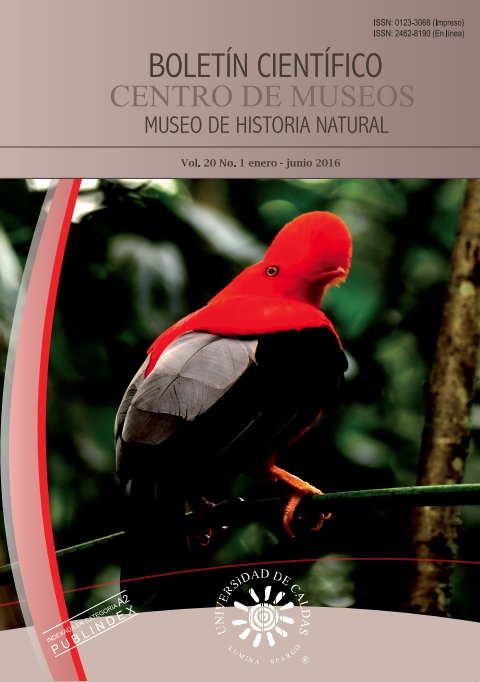Authors
Abstract
The highAndean forests are ecosystems that are the home to important samples of Colombian biodiversity. They constitute a habitat for numerous species and perform important functions, among them hydrological regulation. Nevertheless, human activities affect these important resource putting at risk their composition and function. Therefore, it is necessary to increase biological knowledge of the ecosystems and define measures for its conservation.
As a response to the above, the objective of this research was to describe the vegetation present in the highAndean forests ecosystem between an altitude of 3,200 and 3,400 meters, in the San Juan Forest, inside the National Natural Park of Puracé (PNN), Department of Cauca,Colombia. In order to achieve this goal, Gentry's forest transect methodology was used (DAP ≥ 2,5 in 0,1 ha). The forest studied consisted of 301 individuals classified into 13 families, 18 genera and 38 species. The species with the highest importance value index (IVI) belong to the Cunoniaceae, Chloranthaceae, Melastomataceae, Araceae, Piperaceae and Clusiaceae families, represented by: Weinmannia mariquitae (IVI: 0,96), Hedyosmum sp. (IVI: 0,56), Miconia sp.1 (IVI: 0,25), Anthurium sp. (IVI: 0,13), Piper sp. (IVI: 0,13) and Clusia multiflora (IVI: 0,13), respectively. The forest was characterized by the presence of an abundance of 3 and 5.9 meters high trees. Diversity was calculated in 0.18 using the Simpson Index, with a total of 6.19 m2basal area. It was concluded that San Juan forest possesses a composition and structure typical of high Andean forests described in the Colombian central mountain range. The characteristics of this forest (i.e., transition zone from highAndean forest to moorland –páramo-and its proximity to thermal springs), constitute an important reference point for the conservation of this ecosystem in the Department of Cauca.
References
ALVEAR, M., J. BETANCUR & P. FRANCO-ROSSELLI. 2010.- Diversidad florística y estructura de remanentes bosque andino en la zona de amortiguación del Parque Nacional Natural Los Nevados, Cordillera Central colombiana. Caldasia 32(1): 39-63.
BOHÓRQUEZ A.F., D. SANÍN & N. W. SILVA. 2012.- Estructura y composición arbórea de los Bosques del Diablo (San Félix, Salamina, Caldas) selva alto andino de la cordillera central colombiana. Boletín Científico del Museo de Historia Natural. 16 (2): 39-52.
CAVELIER, J., D. LIZCANO, V. PIZARRO & J. CARMONA. 2000.- Distribución, tamaño poblacional y actividad de la Danta de Montaña ( Tapirus pinchaque) en Colombia. Journal of Biogeography 29: 7-15.
CLEEF, A. M., J.O. RANGEL-CH. & S. SALAMANCA. 1983. Reconocimiento de la vegetación de la parte alta del transecto Parque Nacional Natural Los Nevados. Págs. 150–173 en: T. van der Hammen, T., A. Pérez & P. Pinto (eds.), La Cordillera Central de Colombia, transecto Parque Nacional Natural Los Nevados. Estudios de Ecosistemas Tropandinos vol. 1. J. Cramer, Berlín.
CURTIS, J.T., & MCINTOSH, R. 1951.- An unpland forest continuum in the prairie-forest border región of Wisconsin. Ecology 32: 476-496.
GENTRY, A. H. 1986.- Species richness and floristic composition of Chocó region plant communities. Caldasia 5: 71-75.
GENTRY, A. H. 1993.- A field guide to the families and genera of woody plants of northwest South America (Colombia, Ecuador, Perú). The University of Chicago. Chicago and London. 895 p.
MENDOZA, H. & B. RAMÍREZ. 2006.- Guía ilustrada de géneros de MELASTOMATACEAE y MEMECYLACEAE de Colombia. Instituto de Investigación de Recursos Biológicos Alexander von Humboldt. Grupo de Exploración y Monitoreo Ambiental GEMA. Universidad del Cauca. Departamento de Biología. 285p.
MONTENEGRO, O.L & O. VARGAS. 2008.- Caracterización de bordes de bosque alto andino e implicaciones para la restauración ecológica en la Reserva Forestal de Cogua (Colombia). Revista Biología Tropical. 56 (3): 1543-1556.
RANGEL, O & A. VELÁSQUEZ. 1997.- Métodos de estudio de la vegetación. P 59 – 87. En: RANGEL, O., P.D. LOWY & M. AGUILAR. 1997. Colombia diversidad biótica II. Universidad Nacional de Colombia. Bogotá.
RIVERA, D. 2001.- Páramos de Colombia. Imprelibros S.A. Colombia. 256 p.
SÁNCHEZ, F. 2006.- Estudio preliminar para la conservación de la danta de montaña ( Tapirus pinchaque) en el municipio de Puracé, corregimiento de Paletará, Cauca, Colombia. Cali. Fundación Zoológica de Cali. 41p.
SANDOVAL, S. 2005.- Evaluación preliminar del estado poblacional de la danta de montaña ( Tapirus pinchaque) en el sector norte del Parque Nacional Puracé, Cauca, Colombia. Cali. Fundación Zoológica de Cali. 125 p.
SARMIENTO, C., C. CADENA, M. SARMIENTO, J. ZAPATA & O. LEÓN. 2013.- Aportes a la conservación estratégica de los páramos de Colombia: Actualización de la cartografía de los complejos de páramo a escala 1:100.000. Instituto de Investigación de Recursos Biológicos Alexander von Humboldt. Bogotá, D.C. Colombia. 46 p.
TOBÓN, C. 2009.. Los bosques andinos y el agua. Serie investigación y sistematización #4. Programa Regional ECOBONA – INTERCOOPERATION, CONDESAN. Quito. 122 p.
VARGAS. W. 2002.- Guía Ilustrada de las montañas del Quindío y los Andes Centrales. P 253 – 255. Centro Editorial. Universidad de Caldas. Manizales. 814 p.
VARGAS, O. J & P. GÓMEZ. 2008.- Rasgos De Historia De Vida De Especies Pioneras En La Reserva Natural Ibanasca (Ibagué, Tolima, Colombia). En: BARRERA, J.I., AGUILAR, M & D.C. RONDÓN. 2008. Experiencias de Restauración Ecológica en Colombia "entre la sucesión y los disturbios". Escuela de Restauración Ecológica (ERE) y Universidad Javeriana. 89 p.
VILLAREAL, H., M. ÁLVAREZ, S. CORDOBA, F. ESCOBAR, G. FAGUA, F. GAST, H., MENDOZA, M., OSPINA & UMAÑA A.M. 2004.- Manual de métodos para el desarrollo de inventarios de biodiversidad. Programa de Inventarios de Biodiversidad. Instituto de Investigación de Recursos Biológicos Alexander von Humboldt. Bogotá, Colombia. 236 p.

 PDF (Español)
PDF (Español)
 FLIP
FLIP






















